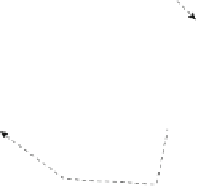Information Technology Reference
In-Depth Information
structures where the magnetization lies out of plane [
25
-
27
]. The clock is an
oscillating magnetic field applied perpendicular to the plane. No clock zones are
used because the magnetic field is applied globally to the circuit.
Copper Wires
Magnets
(Bit and Source lines)
Ferrite
Yoke
I
I
I
I
H
I
I
I
I
Copper
I
B)
A)
Wire
Piezoelectric Layer
(PZT)
H
Strain
H
Electric Field
t
C
D
V
Electrodes
Fig. 3.
NML main clock systems. (A) Magnetic field clock. A magnetic field is generated
by a current flowing through a wire placed under the magnets plane. (B) STT clock.
Spin-Torque coupling due to a current flowing through the magnets, which in this
case are MTJ junctions. (C) Magnetoelastic clock. The mechanical stress induced by
the strain of a piezoelectric layer at which a voltage is applied forces magnets in the
RESET state. (D) Out-of-plane NML clock. In this particular implementation of NML,
the magnetization of each dots points out-of-plane. The clock is an oscillating magnetic
field applied perpendicularly to the plane. No clock zones are present because clock
field is applied uniformly to the entire circuit.
The clock generation system is important from the circuits architecture point
of view because it has a strong impact on the layout of the clock zones. Particu-
larly, to drive the currents and the voltages required by different clock systems,
wires must be properly routed through the circuit. Thanks to the size of these
wires and the limitations of the technological processes available, not every clock
zones layout is possible. Different clock systems have different constraints. For
example, relatively to the magnetic field clock we have developed the “snake-
clock” system [
15
,
18
]. The clock zones layout is outlined in Fig.
4
(A). Clock zones
are made by parallel strips that represent the physical wires used to generate the
magnetic field. To propagate correctly, signals must be routed through a precise
sequence of clock zones, from zone 1 to zone 2 and finally to zone 3. As can be
seen from Fig.
4
(A), with this clock zone layout, magnets can propagate in only
one direction, from left to right. Moreover, signals cannot propagate vertically
in the same clock zone because the number of magnets that can be cascaded is












































































































Search WWH ::

Custom Search